New York City Mayor Eric Adams today celebrated the New York City Council’s passage of the Resilient Edgemere Community Plan. The vote paves the way for the creation of approximately 530 new affordable homes, 35 percent of which will be set aside for affordable homeownership opportunities. The plan includes a new Community Land Trust that will identify partners to own up to eight acres of city-owned land, new resiliency, and coastal protection measures for vulnerable areas in the neighborhood, new retail and commercial opportunities near transit and pedestrian corridors, and millions of dollars in new infrastructure investments to create a stronger, more resilient Edgemere neighborhood.
“With the Resilient Edgemere Community Plan, my administration is delivering over 500 new affordable homes, urgent resiliency measures, and critical neighborhood infrastructure investments — an important step forward for residents of Edgemere, the Rockaways, and the entire city,” said Mayor Eric Adams. “I want to thank Speaker Adams and Councilmember Brooks-Powers for working with us so closely to pass this plan, and I look forward to continued partnership with the speaker and the City Council to tackle our affordable housing crisis, equip our neighborhoods for a changing climate, and help our city recover from the pandemic.”
“The Resilient Edgemere Community Plan will bring deeply needed affordable housing opportunities, resiliency upgrades, and coastal protections to the Edgemere neighborhood,” said Deputy Mayor for Economic and Workforce Development Maria Torres-Springer. “As we plan for an equitable recovery in the face of a housing crisis and the growing threats of climate change, this multi-year, interagency effort is an important model of thoughtful, holistic neighborhood planning. Thank you to Speaker Adams and Councilmember Brooks-Powers for their partnership in the successful passage to build a stronger, more resilient Edgemere.”
“This is a great win for the Edgemere community and the city as a whole,” said Chief Housing Officer Jessica Katz. “The Resilient Edgemere Plan shows how important community-based planning is to ensuring we continue to build critically needed new homes, while also prioritizing vital protections for our coastal neighborhoods in the face of a changing climate. I want to thank HPD, DCP, and Councilmember Brooks-Powers for working together and helping us become the ‘City of Yes’ we need to be in order to house our neighbors.”
“This momentous step forward for the Resilient Edgemere Plan is the result of a multi-year partnership between HPD and the Edgemere community and a testament to the value of community-based planning,” said New York City Department of Housing Preservation and Development (HPD) Commissioner Adolfo Carrión Jr. “Together we developed a comprehensive framework that creates desperately needed affordable housing, increases homeownership opportunities, improves flexibility for more diverse retail and other desired community uses, and activates vacant land for public benefit. The plan achieves these goals, while adopting measures that invest in resiliency-focused infrastructure and land use policies that will protect this neighborhood from climate change and sea-level rise. We are grateful to Mayor Adams, Speaker Adams, Councilmember Brooks-Powers, and the other members of the City Council who voted to approve this application and look forward to continuing on our path to realizing this vision for the future of Edgemere."
“As a new special coastal risk district, which includes resiliency measures and affordable housing, this community-first plan for Edgemere puts the health, safety, and equity of its residents and workers front and center,” said New York City Department of City Planning (DCP) Director and City Planning Commission Chair Dan Garodnick. “The plan will help this underserved Rockaways neighborhood thrive for years to come. Congratulations to Councilmember Selvena Brooks-Powers, Queens Borough President Donovan Richards, and everyone involved in getting it to the finish line.”
The plan builds on the city’s broader resiliency planning efforts in the area, including over $80 million in investments in coastal protection projects and nearby NYCHA upgrades in recent years. This includes $14 million for a raised shoreline, an elevated berm that will protect Edgemere against 30 inches of sea level rise, and $68 million in improvements to NYCHA’s Beach 41st St. Houses and Beach 41st St. Cornerstone Community Center.
New infrastructure investments associated with the plan include $2.3 million in critical sewer and drainage infrastructure upgrades. The city will also prioritize the widening of portions of Edgemere Avenue, between Beach 38th Street and Beach 62nd Street, and the construction of a new publicly owned parking lot at Beach 60th Street and Rockaway Beach Boulevard.
Today’s vote is the culmination of over seven years of community planning work led by HPD in coordination with multiple city agencies and community partners and memorialized in the 2017 Resilient Edgemere Community Plan document.








